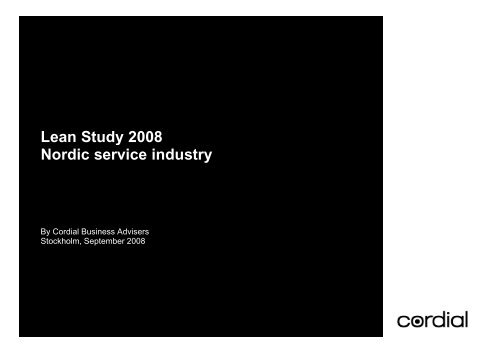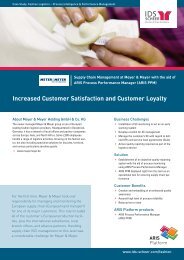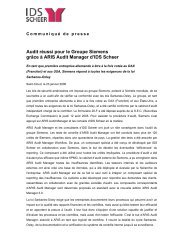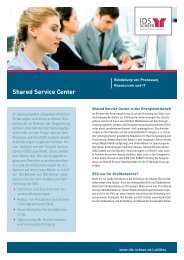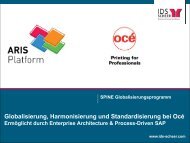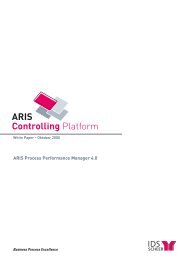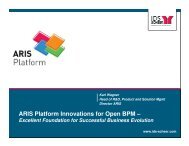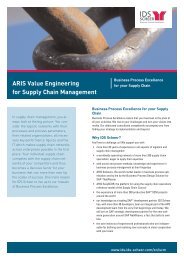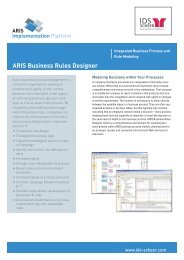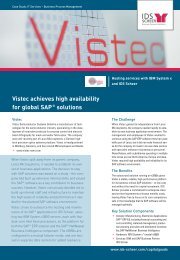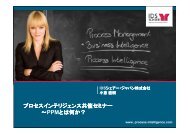Lean Study 2008 Nordic service industry - Cordial
Lean Study 2008 Nordic service industry - Cordial
Lean Study 2008 Nordic service industry - Cordial
You also want an ePaper? Increase the reach of your titles
YUMPU automatically turns print PDFs into web optimized ePapers that Google loves.
<strong>Lean</strong> <strong>Study</strong> <strong>2008</strong><br />
<strong>Nordic</strong> <strong>service</strong> <strong>industry</strong><br />
By <strong>Cordial</strong> Business Advisers<br />
Stockholm, September <strong>2008</strong>
1<br />
About <strong>Cordial</strong> <strong>Lean</strong> study <strong>2008</strong> A selection of participating companies<br />
• This <strong>Lean</strong> study was carried out during April – July <strong>2008</strong><br />
targeting different industries within the <strong>service</strong> sector and<br />
<strong>service</strong> related processes at manufacturing companies, e.g.<br />
procurement, sales and business development units.<br />
� The study aims to get a “pulse check” regarding state-of-theart<br />
development of <strong>Lean</strong> at selected <strong>service</strong> companies in<br />
the <strong>Nordic</strong> and Japan.<br />
� The study y is based on 44 interviews with key yppersons<br />
at the<br />
companies, e.g. business developers, process owners, Vice<br />
Presidents, <strong>Lean</strong> Managers etc.<br />
Key findings<br />
• 79% of the companies p working g with <strong>Lean</strong> said to have achieved bottom line results, , compared p to 47% of the companies p working g<br />
with other continuous process improvements.<br />
• 53% of the companies currently not working with <strong>Lean</strong> are planning to implement <strong>Lean</strong> in the future.<br />
• <strong>Lean</strong> is regarded as a mean to achieve cost efficiency and customer satisfaction.<br />
• <strong>Lean</strong> is a well recognized concept in the <strong>Nordic</strong> Service <strong>industry</strong>: 95% are familiar with <strong>Lean</strong> as a concept.<br />
• Various <strong>Lean</strong> tools are used when working with <strong>Lean</strong>, 5 S and Value Stream Mapping being the most common tools.<br />
• Main challenges when working with <strong>Lean</strong> incorporate having the right leadership, creating a sustainable employee commitment,<br />
having the right communication, establishing clear work process, roles & a toolbox as well as linking the bottom line effect to the<br />
<strong>Lean</strong> work.<br />
© <strong>2008</strong> <strong>Cordial</strong> Business Advisers AB<br />
<strong>2008</strong>-05-08 Projektnamn och konsult Fil: filnamn.ppt
2<br />
Table of contents<br />
�� About the study<br />
� A few words about <strong>Lean</strong><br />
� Results of the <strong>Lean</strong> study y <strong>2008</strong><br />
� Conclusions and reflections<br />
� Contact information<br />
© <strong>2008</strong> <strong>Cordial</strong> Business Advisers AB
3<br />
Background and purpose of <strong>Cordial</strong>’s <strong>Lean</strong><br />
<strong>Study</strong> <strong>2008</strong><br />
� <strong>Lean</strong> is one of the most far-reaching management philosophies when it comes to process<br />
improvement. The manufacturing <strong>industry</strong> has for a long time been the pioneering <strong>industry</strong> in<br />
which <strong>Lean</strong> has been developed and successfully implemented.<br />
BBackground k d<br />
� In recent years <strong>Lean</strong> has made the leap to the <strong>service</strong> <strong>industry</strong>. In order to support our<br />
Purpose<br />
Definition of<br />
<strong>Lean</strong> in this<br />
study<br />
© <strong>2008</strong> <strong>Cordial</strong> Business Advisers AB<br />
customers in further developing their businesses, we wish to gain an understanding of the<br />
status of <strong>Lean</strong> programs and the relation to other process improvement initiatives at <strong>Nordic</strong><br />
<strong>service</strong> companies.<br />
� To perform a “pulse check” regarding state-of-the-art development of <strong>Lean</strong> in selected<br />
<strong>service</strong> i companies i iin N<strong>Nordic</strong> di and d JJapan tto get t an understanding d t di of f how h these th companies i<br />
work with process improvements<br />
� Pinpoint overall trends, challenges and success factors for companies working with <strong>Lean</strong><br />
� Continuous process improvement work based on <strong>Lean</strong> principles or <strong>Lean</strong> inspired methods
4<br />
The study includes a wide range of industries in the<br />
<strong>Nordic</strong> <strong>service</strong> sector…<br />
11%<br />
7%<br />
7%<br />
5%<br />
7%<br />
7%<br />
7%<br />
© <strong>2008</strong> <strong>Cordial</strong> Business Advisers AB<br />
9%<br />
15%<br />
11%<br />
14%<br />
Healthcare<br />
Telecom & Media<br />
Retail<br />
Public organizations<br />
IT Consulting<br />
Transport p & Logistics g<br />
Manufacturing<br />
Construction<br />
Banking<br />
Energy egy<br />
Hospitality & travel<br />
Total: 44 companies p<br />
Comments:<br />
44 interviews with key persons of <strong>Nordic</strong> companies have been conducted<br />
�� Focus lies on the <strong>service</strong> sector<br />
and <strong>service</strong> related processes at<br />
manufacturing companies, e.g.<br />
procurement, sales and<br />
business development units<br />
� The interviewed companies<br />
represent 11 different <strong>industry</strong><br />
segments<br />
� At each company, <strong>Cordial</strong> has<br />
interviewed key persons persons, ee.g. g<br />
business developers, process<br />
owners, vice presidents, <strong>Lean</strong><br />
Managers etc.
5<br />
… and interviews have been conducted with some<br />
major players in each segment<br />
Healthcare Retail Banking<br />
Telecom & Media Transport & Logistics Other<br />
© <strong>2008</strong> <strong>Cordial</strong> Business Advisers AB
6<br />
Table of contents<br />
�� About the study<br />
� A few words about <strong>Lean</strong><br />
� Results of the <strong>Lean</strong> study y <strong>2008</strong><br />
� Conclusions and reflections<br />
� Contact information<br />
© <strong>2008</strong> <strong>Cordial</strong> Business Advisers AB
7<br />
What is <strong>Lean</strong> all about?<br />
© <strong>2008</strong> <strong>Cordial</strong> Business Advisers AB<br />
<strong>Lean</strong> is about optimizing a company’s processes and working<br />
methods by counteracting waste, focusing on the value-adding<br />
activities ti iti and d creating ti a culture lt characterized h t i d bby continuous ti<br />
improvements.
8<br />
<strong>Lean</strong>’s basic principles – <strong>Lean</strong> Thinking<br />
Place the customer as<br />
number 1<br />
Remove obstacles<br />
Competence & mandate<br />
Source: <strong>Cordial</strong> research<br />
Involvement<br />
Eliminate waste!!!<br />
© <strong>2008</strong> <strong>Cordial</strong> Business Advisers AB<br />
• Al Always ddoing i or making ki th the choices h i th that t are bbest t ffor<br />
the customer<br />
• Remove all obstacles that are preventing the customer to<br />
get what they want.<br />
• Make sure that all employees have the relevant skills and<br />
competence which makes it possible to meet the<br />
customer’s expectations.<br />
• Leaders involve their co-workers in the decisions that<br />
affect their work and coach them on a daily basis.<br />
• Always be on the look out for waste and when the<br />
waste is discovered it must be eliminated.
9<br />
Where is <strong>Lean</strong> applicable in the <strong>service</strong> <strong>industry</strong>?<br />
� <strong>Lean</strong> can be used to improve people and information intensive<br />
processes such as:<br />
• Sales processes<br />
• Service (delivery) process<br />
• After-sales / customer support pp pprocesses<br />
• Front-office processes (meeting customers)<br />
• Administrative processes<br />
• IT processes p<br />
© <strong>2008</strong> <strong>Cordial</strong> Business Advisers AB<br />
Example: Visualization of the workflow<br />
at a Japanese fabrics manufacturer in<br />
Kansai 2005
10<br />
The 7+1 wastes: the manufacturing <strong>industry</strong><br />
© <strong>2008</strong> <strong>Cordial</strong> Business Advisers AB<br />
Overproduction<br />
Manufacturing<br />
To manufacture more or earlier than necessary<br />
Waiting To wait for something to happen<br />
Stock To keep larger stock than necessary<br />
Motion<br />
Re-work<br />
Overwork<br />
Transports<br />
Th The unexploited l i d<br />
creativity of the staff<br />
UUnnecessary movements t and d actions ti which hi h are<br />
performed in order to fulfill a task<br />
Repairs and re-work which do not<br />
add value to the customers<br />
To do more work than the customer requires<br />
Unnecessary transports<br />
This was not part of the original wastes,<br />
but has been added as the eight waste
11<br />
The 7+1 wastes in the <strong>service</strong> <strong>industry</strong> - examples<br />
Overproduction p<br />
Waiting<br />
Stock<br />
People<br />
Performing a task that a colleague is going to<br />
perform anyhow<br />
Waiting for answers from customers, partners or for<br />
a decision to be taken by management<br />
Hiring more employees than there is occupation for<br />
MMotion ti Educating new people when senior people leave<br />
Re-work<br />
Overwork<br />
Transports<br />
The unexploited<br />
creativity of the staff<br />
© <strong>2008</strong> <strong>Cordial</strong> Business Advisers AB<br />
Constantly recapitulating results from the last<br />
meeting if too much time has elapsed between from<br />
the previous one<br />
Information<br />
Producing too much information related to a given<br />
purpose<br />
Waiting to receive important information<br />
Scattered information which is stored in different<br />
locations but which is not compiled for optimal use<br />
Sending documentation physically instead of using<br />
digital formats<br />
Discarding already collected information and<br />
compiling new information if needs have changed<br />
Over-working delivery to a new customer Performing too much research for a given objective<br />
Traveling to different meetings instead of e.g. using<br />
telephone conferences<br />
Unexploited knowledge among the staff as for<br />
instance language g g skills, , earlier experience, p ,<br />
academic records<br />
Information transport through long office turnaround<br />
time, several authorization levels etc<br />
Unexploited information of already performed<br />
studies studies, earlier experience experience, reuse of ideas etc
12<br />
There is currently a large interest for <strong>Lean</strong> Services<br />
”<strong>Lean</strong> Management”<br />
735 000<br />
Source: www.google.com [<strong>2008</strong>-09-03]<br />
© <strong>2008</strong> <strong>Cordial</strong> Business Advisers AB<br />
”<strong>Lean</strong>” <strong>Lean</strong><br />
65 million hits<br />
”<strong>Lean</strong> Services”<br />
17 200 000<br />
”<strong>Lean</strong><br />
Manufacturing”<br />
2 800 000<br />
• Toyota received 600 000<br />
suggestions for improvement<br />
during 2006 from their<br />
employees. 91 per cent of these<br />
were implemented.<br />
• How many suggested<br />
improvements has your<br />
company implemented?
13<br />
<strong>Lean</strong> is also a hot topic in the business press<br />
Financial<br />
Times*<br />
� 1022 articles<br />
Harvard<br />
Business<br />
Review**<br />
* Archive search Jan 1st 2003 and onwards<br />
** Complete online publications about <strong>Lean</strong><br />
© <strong>2008</strong> <strong>Cordial</strong> Business Advisers AB<br />
<strong>Lean</strong> Management <strong>Lean</strong> Production<br />
<strong>Lean</strong> Services<br />
� 1022 articles �� 626 articles<br />
�� 1023 articles<br />
� 286 FT comment &<br />
analysis<br />
� 122 FT comment &<br />
analysis<br />
<strong>Lean</strong> Management <strong>Lean</strong> Production<br />
� 263 FT comment &<br />
analysis<br />
<strong>Lean</strong> Services<br />
� 186 articles � 113 articles � 188 articles
14<br />
Table of contents<br />
�� About the study<br />
� A few words about <strong>Lean</strong><br />
� Results of the <strong>Lean</strong> study y <strong>2008</strong><br />
� Conclusions and reflections<br />
� Contact information<br />
© <strong>2008</strong> <strong>Cordial</strong> Business Advisers AB
15<br />
<strong>Lean</strong> is a well recognized concept in the <strong>Nordic</strong><br />
Service <strong>industry</strong><br />
Comments<br />
Are you y familiar with the concept p of <strong>Lean</strong>? �� Most of the respondents are<br />
familiar of the <strong>Lean</strong> origin from<br />
5%<br />
the manufacturing <strong>industry</strong> and<br />
Toyota<br />
� The curiousness for <strong>Lean</strong><br />
<strong>service</strong>s is high in general<br />
among the respondents<br />
© <strong>2008</strong> <strong>Cordial</strong> Business Advisers AB<br />
95%<br />
Yes<br />
No<br />
Total: 44 companies p<br />
95% are familiar with <strong>Lean</strong> as a concept<br />
Quotations from interviews:<br />
“II have heard about The Toyota<br />
way and <strong>Lean</strong> in the manufacturing<br />
<strong>industry</strong> sector”<br />
“I’m familiar with the concept and it<br />
is exciting to see what results it can<br />
bring”
16<br />
<strong>Lean</strong> is used by 65% of the companies working with<br />
continuous process improvements<br />
Do you feel that your processes are optimized today or do<br />
you y work with continuous process p improvements?<br />
p<br />
2%<br />
Comments<br />
98%<br />
Continuous process improvement<br />
Optimized p pprocesses<br />
Do you currently work with continuous process improvements<br />
based on <strong>Lean</strong> principles? p p<br />
� Nearly all companies (98%) claim to work with continuous improvements (not always expressed as <strong>Lean</strong>)<br />
�� A majority (65%) work with continuous process improvements based on <strong>Lean</strong> principles/methods<br />
© <strong>2008</strong> <strong>Cordial</strong> Business Advisers AB<br />
Total: 44 companies<br />
35%<br />
65%<br />
Total: 43 companies<br />
Yes<br />
No
17<br />
<strong>Lean</strong> is also of high interest for companies currently not<br />
working with <strong>Lean</strong> methods<br />
Are you y planning p g to work with <strong>Lean</strong> in the future?<br />
47%<br />
Comments<br />
�� OOut t of the 15 companies (35%)<br />
that doesn’t work with <strong>Lean</strong>,<br />
53% plan to start work with <strong>Lean</strong><br />
in the future<br />
Quotations from interviews:<br />
Yes<br />
”We will definitely work with<br />
something <strong>Lean</strong>-inspired in the future”<br />
Plats för diagram eller tabell<br />
53% No<br />
“It It is an interesting method and we<br />
will definitely evaluate it later on”<br />
“We will start working with <strong>Lean</strong> next<br />
year. We are currently working with<br />
an extensive overview of our<br />
processes”<br />
Total: 15 companies* p<br />
53% of the companies not currently working expressed with <strong>Lean</strong> are planning to implement <strong>Lean</strong> in the<br />
future<br />
* 15 companies doesn’t work with <strong>Lean</strong> principles today<br />
© <strong>2008</strong> <strong>Cordial</strong> Business Advisers AB
18<br />
<strong>Lean</strong> puts a greater emphasis on customer focus as<br />
opposed to other continuous improvement initiatives<br />
What’s the main reason(-s) for your <strong>Lean</strong> work?*<br />
16%<br />
0%<br />
0%<br />
Comments<br />
12%<br />
42%<br />
30%<br />
Cost efficiency<br />
Increased cust omer ffocus ocus<br />
St rong compet it ion<br />
Qualit y<br />
All of t he above<br />
OOt<br />
her<br />
16%<br />
� Main reason for the <strong>Lean</strong> work is increased customer focus (42%)<br />
and continuous process improvements concentrates mainly on cut<br />
costs<br />
� Other reasons include: increased productivity, reduced waste,<br />
engage workers etc.<br />
© <strong>2008</strong> <strong>Cordial</strong> Business Advisers AB<br />
8%<br />
What’s the main reason(-s) for your continuous process<br />
improvements work?<br />
12% 32%<br />
12%<br />
20%<br />
Cost ef f iciency<br />
Incr eased customer f ocus<br />
Str ong competi ti on<br />
Quality<br />
Al l of the above<br />
Other<br />
Quotations from interviews:<br />
“Everything we do aims to increase customer focus”<br />
“Management is pushing hard on costs, but for me<br />
customer focus is most important important”
19<br />
Bottom line results can be achieved through general<br />
continuous process improvement work…<br />
Have you y achieved bottom line effects due to yyour work with continuous pprocess<br />
improvements?<br />
Comments<br />
�� Cost efficiency and increased<br />
revenues are some examples of<br />
19%<br />
success gained through using<br />
continuous process<br />
Yes<br />
improvements work<br />
Don't know , don't<br />
14% measure<br />
67%<br />
No<br />
Total: 43 companies*<br />
Quotations from interviews:<br />
”Increased revenues thanks to<br />
<strong>Lean</strong>!”<br />
”Cut costs have resulted in<br />
increased profitability”<br />
”We have achieved better managed<br />
costs as well as cost efficiency”<br />
“We have reduced waiting-time in<br />
our emergency room which leads to<br />
reduced costs”<br />
67% have achieved bottom line results from their work with continuous process improvements<br />
* One company does not work with continuous improvements<br />
© <strong>2008</strong> <strong>Cordial</strong> Business Advisers AB
20<br />
…but it’s more likely to achieve bottom line results working<br />
with <strong>Lean</strong>!<br />
Bottom line results achieved by <strong>Lean</strong> Bottom line results achieved by general process<br />
improvements work (a part from <strong>Lean</strong>)<br />
0%<br />
21%<br />
Comments<br />
79%<br />
Yes<br />
No<br />
Don't know/don't measure<br />
53%<br />
� Among the 29 companies working with <strong>Lean</strong>, 79% have seen bottom line results<br />
0%<br />
47%<br />
Yes<br />
No<br />
Don't know/ don't measure<br />
• Out of the 21% who hasn’t seen bottom line results, some have not yet started to measure and some don’t measure fiscal<br />
results<br />
� Among the companies working with general continuous process improvements only 47% achieved bottom line results<br />
79% of the companies working expressed with <strong>Lean</strong> achieved bottom line results compared to 47%<br />
working ki with ith ordinary di continuous ti process improvement i t workk<br />
© <strong>2008</strong> <strong>Cordial</strong> Business Advisers AB
21<br />
Employees are overall positive towards the implementation<br />
of continuous process improvements<br />
Comments<br />
How does your y employees p y react to continuous pprocess improvements?* p<br />
�� A vast majority, 84%, claims that<br />
the continuous process<br />
improvement work has been<br />
positively received by the<br />
employees<br />
�� SSome companies i hhave received i d<br />
84%<br />
*<br />
both reactions<br />
Quotations from interviews:<br />
”If the workers are part of the<br />
process change and have the ability<br />
2%<br />
Positively<br />
to influence it, the change is received<br />
much better”<br />
Negatively ”Initially we get a negative reaction<br />
14%<br />
Mixed<br />
but when the employees p y see that the<br />
change works the reactions turn<br />
positive”<br />
”How the process change is received<br />
Total: 43 companies** p<br />
depends on what kind of change it<br />
is” is<br />
84 % believe that their employees are positive towards continuous process improvement work<br />
* Only key persons have been interviewed except from 7 companies where in depth interviews have been made with employees<br />
** One company does not work with continuous improvements<br />
© <strong>2008</strong> <strong>Cordial</strong> Business Advisers AB
22<br />
Greater involvement of employees in <strong>Lean</strong> initiatives<br />
How does your organization seek improvement of processes?<br />
Companies working with <strong>Lean</strong> Companies working with general process<br />
improvements<br />
39% Employee driven<br />
Comments<br />
11%<br />
50%<br />
Management driven<br />
Both<br />
� “Management-only”-driven improvement work is less common<br />
among companies working with <strong>Lean</strong><br />
�� It is common for the management to setup guidelines but the<br />
employees execute and optimize specific processes<br />
© <strong>2008</strong> <strong>Cordial</strong> Business Advisers AB<br />
33%<br />
20%<br />
47%<br />
Fråga Linda B!!<br />
Checka titel!!!<br />
Employee driven<br />
Management driven<br />
Both<br />
Quotes from interviews:<br />
“The decision to work with <strong>Lean</strong> came from management but<br />
the “pull” from employees keep on increasing”<br />
“Each Each employee can make a suggestion directly to a process<br />
owner who evaluate and decide on what to do”
23<br />
Process improvement work is more prioritized by<br />
Management in companies working with <strong>Lean</strong><br />
How is the work with continuous process improvements prioritized on the management’s agenda?<br />
Priority on the Management agenda in<br />
Priority on the Management agenda with general process<br />
companies working with <strong>Lean</strong><br />
Improvements<br />
Comments<br />
10 %<br />
3%<br />
87%<br />
� A vast majority consider their continuous process<br />
improvement work as a top issue by management<br />
�� Only 3% consider the work with <strong>Lean</strong> as a low priority by<br />
Management compared to 20% in companies working with<br />
general process improvements<br />
20%<br />
High<br />
High<br />
Average<br />
Average<br />
Low<br />
Low<br />
53% 3%<br />
27%<br />
Quotations from interviews:<br />
”Without the strong commitment from the management it<br />
wouldn't been possible to launch <strong>Lean</strong> so widely”<br />
”<strong>Lean</strong> is a top priority by our management management, it is a critical<br />
success factor”<br />
87% consider their continuous process improvement work to be highly prioritized by management in<br />
<strong>Lean</strong> companies compared to 53% in companies working with general process improvements<br />
© <strong>2008</strong> <strong>Cordial</strong> Business Advisers AB
24<br />
There is an equal share in how companies choose to<br />
implement their <strong>Lean</strong> work…<br />
How extensive is your y <strong>Lean</strong> work?<br />
Comments<br />
�� The most common processes to<br />
48%<br />
52%<br />
start with are core processes,<br />
product & <strong>service</strong> development<br />
and administrative processes<br />
Selected processes<br />
Plats för diagram eller Whole tabell organization g<br />
Total: 29 companies* p<br />
Quotations from interviews:<br />
”We’ve used pilots so far but have<br />
a very good impression and our<br />
ambition is to take it to the whole<br />
organization”<br />
”We’ve started with <strong>Lean</strong> in our<br />
emergency rooms and now we will<br />
expand to other departments as<br />
well”<br />
… but many plan to expand their process improvement work to other units/the entire organization<br />
utilizing the “power of successes”<br />
* 29 companies work with <strong>Lean</strong><br />
© <strong>2008</strong> <strong>Cordial</strong> Business Advisers AB
25<br />
5S and VSM are the most common tools for<br />
companies working with <strong>Lean</strong><br />
Do you y follow a given g method within yyour pprocess improvement p work? If y yes, , which one?<br />
Comments<br />
�� More than 60% are using <strong>Lean</strong><br />
tools<br />
64%<br />
• Value Stream Mapping<br />
(VSM) & 5S are the most<br />
11<br />
5S<br />
VSM<br />
Standards<br />
common tools<br />
� DMAIC is the most common tool<br />
when working with Six Sigma<br />
9<br />
Plats för diagram eller tabell Whiteboard meetings g Quotations from interviews:<br />
4<br />
2<br />
9<br />
28%<br />
5<br />
8%<br />
3<br />
Other<br />
DMAIC<br />
Other<br />
”We use a combination of both<br />
methods, we choose what fits our<br />
organization best”<br />
”The two systems (<strong>Lean</strong>, Six<br />
Si Sigma) ) complement l t each h other th<br />
well”<br />
”We have our own methods based<br />
<strong>Lean</strong> Tools Six Sigma Other<br />
Total: 43 responses* responses<br />
on the more traditional <strong>Lean</strong> tools”<br />
Number of o responsess<br />
64 % of the companies working with a given method in their process improvement work choose <strong>Lean</strong><br />
basic tools<br />
* Not all companies work with <strong>Lean</strong>, possible to chose multiple alternatives for the ones who did reply on this question<br />
© <strong>2008</strong> <strong>Cordial</strong> Business Advisers AB
26<br />
There are challenges and success factors to consider when<br />
working with the implementation of <strong>Lean</strong><br />
CHALLENGES SUCCESS FACTORS<br />
Having the right leadership<br />
� To have a coaching leadership that makes room for a <strong>Lean</strong><br />
culture to grow as well as creating a leadership characterized<br />
by trust toward the employees.<br />
Achieving a sustainable organisational commitment<br />
� To break down the process’ KPI to an individual level.<br />
� Invest in long-term employee development<br />
Having the right communication<br />
� To communicate early and in the right way to both direct and<br />
indirect involved stakeholders.<br />
Establishing clear work process process, roles & a toolbox<br />
� To establish proper structure (roles, responsibilities and<br />
mandate) before, during and after the <strong>Lean</strong> implementation in<br />
order to achieve permanent effects.<br />
� To know which tools to use and how to apply them effectively<br />
in the work process<br />
Linking the bottom line effect to the <strong>Lean</strong> work<br />
� To be able to link the process KPIs to the bottom line effect<br />
resulting from the <strong>Lean</strong> work.<br />
© <strong>2008</strong> <strong>Cordial</strong> Business Advisers AB<br />
100% management attention & commitment<br />
� Management needs to understand, support and believe in<br />
<strong>Lean</strong> for successful implementation.<br />
Keeping the employees motivated<br />
� Share success stories, good impressions and experiences<br />
from customer meetings with the rest of the organization.<br />
To answer “What’s in it for me?<br />
Ed Education ti & training t i i<br />
� Continuously train and educate during the implementation<br />
and tailor it for every phase of the implementation.<br />
Communication Strategy gy & Plan<br />
� A well thought-through communication plan (top-down<br />
approach), connected to a stakeholder analysis, will<br />
minimize resistance and maximize acceptance within the<br />
organization.<br />
Let the customers be one of the driving forces<br />
� Continuous improvements should not be driven by<br />
customer complaints but rather by a understanding of<br />
customer needs.
27<br />
Summary of results from the <strong>Lean</strong> study <strong>2008</strong> (1/2)<br />
There is<br />
currently a<br />
large interest<br />
for <strong>Lean</strong><br />
Services<br />
� <strong>Lean</strong> is a well recognized concept in the <strong>Nordic</strong> Service <strong>industry</strong><br />
• 95% are familiar with <strong>Lean</strong> as a concept<br />
� There is currently a high interest in <strong>Lean</strong> Services in the <strong>Nordic</strong> <strong>service</strong> sector<br />
• 65% of the companies working with continuous process improvements are using<br />
<strong>Lean</strong> principles<br />
�� <strong>Lean</strong> is also an up up-and-coming and coming opportunity for companies currently not working with <strong>Lean</strong><br />
methods<br />
• 53% of the companies not currently working with <strong>Lean</strong> are planning to implement<br />
<strong>Lean</strong> in the future<br />
� <strong>Lean</strong> puts a greater emphasize on customer focus opposed to general process<br />
improvements<br />
� General continuous process improvements is foremost used for cost efficiency<br />
The <strong>Lean</strong> work<br />
� It’s more likely to achieve bottom line results working with <strong>Lean</strong><br />
often show<br />
• 79% of the companies working with <strong>Lean</strong> achieved bottom line results compared to<br />
great t results lt 47% working orking with ith general process impro improvement ement work ork (not <strong>Lean</strong>)<br />
© <strong>2008</strong> <strong>Cordial</strong> Business Advisers AB
28<br />
Summary of results from the <strong>Lean</strong> study <strong>2008</strong> (2/2)<br />
Employees are<br />
frequently<br />
involved in the<br />
<strong>Lean</strong> work and<br />
the priority on<br />
th the<br />
Management<br />
Agenda is high<br />
VSM and 5S are<br />
the most<br />
commonly<br />
used dL <strong>Lean</strong><br />
tools<br />
© <strong>2008</strong> <strong>Cordial</strong> Business Advisers AB<br />
� Process improvements are mainly suggested by employees in a <strong>Lean</strong><br />
environment<br />
• “M “Management-only” t l ” ddriven i approach h iis lless common iin L<strong>Lean</strong><br />
cases.<br />
� Process improvement work is higher prioritized by Management in companies working<br />
with <strong>Lean</strong><br />
• 87% consider their continuous process improvement work to be highly prioritized by<br />
management in <strong>Lean</strong> companies compared to 53% in companies working with<br />
general process improvements<br />
� 64% of the companies working with continuous process improvement use methods<br />
commonly y recognized g as <strong>Lean</strong> tools<br />
�5S and VSM are the most common tools<br />
� 28 % of the companies use SixSigma method
29<br />
Quotations from the interviews (1/2)<br />
Working with <strong>Lean</strong><br />
made it possible p to<br />
expand without<br />
taking on new staff<br />
Healthcare<br />
Revolutionary results!<br />
Healthcare<br />
We’ve seen a prominent<br />
improvement in<br />
productivity as a result of<br />
<strong>Lean</strong><br />
T t & L i ti<br />
The management has<br />
to work in it themselves<br />
to fully understand what<br />
<strong>Lean</strong> is about in reality<br />
Retail<br />
Management has their<br />
own result board for their<br />
<strong>Lean</strong> work<br />
Energy<br />
At the same time as the costs<br />
have been reduced, the quality<br />
has increased<br />
Telecom & Media<br />
Our productivity has increased with<br />
5-10% per year and during the<br />
same time the complaints have<br />
Transport & Logistics diminished<br />
© <strong>2008</strong> <strong>Cordial</strong> Business Advisers AB<br />
We’ve We ve managed to<br />
attract contracts thanks<br />
to our <strong>Lean</strong>-thinking<br />
IT & Consulting<br />
Retail<br />
The easier it is to see concrete<br />
results, the higher g interest in<br />
the organization<br />
Transport & Logistics<br />
A critical success factor is<br />
the interest and high priority<br />
from management<br />
IT & Consulting<br />
Dramatic cut in costs<br />
and increased<br />
control at the same<br />
Retail<br />
As long as the staff can be part of<br />
the planning of a change they are<br />
satisfied when it arrives<br />
Manufacturing
30<br />
Quotations from the interviews (2/2)<br />
Quotations on employee level Quotations on PL and Top Management level<br />
I was stripped of<br />
my responsibility<br />
when the <strong>Lean</strong><br />
implementation<br />
started<br />
WWorking ki with ith L<strong>Lean</strong><br />
has given us a<br />
new mindset even<br />
in other areas<br />
The success<br />
of <strong>Lean</strong><br />
ddepends d<br />
75% on the<br />
leadership<br />
and 25% on<br />
the project<br />
lleaders d<br />
© <strong>2008</strong> <strong>Cordial</strong> Business Advisers AB<br />
Th The project j t lleaders d<br />
must possess<br />
empathy and<br />
experience<br />
We have to find<br />
time outside regular<br />
working hours<br />
(evenings (evenings,<br />
weekends) in order<br />
to work with <strong>Lean</strong> –<br />
it is difficult<br />
Service in is all about<br />
timing – e.g. to know when<br />
it is i suitable it bl to t refill fill the th<br />
water to a restaurant<br />
customer, that is what<br />
makes the difference in the<br />
customer experience!<br />
<strong>Lean</strong> has had a<br />
small effect on the<br />
culture<br />
We don’t see<br />
<strong>Lean</strong> as a<br />
mindset but<br />
rather as a tool<br />
800 opinions<br />
from customers<br />
in 3-4 months<br />
which stimulate<br />
the continuous<br />
improvements<br />
It is important to<br />
know “HOW” to<br />
motivate others<br />
The goal is to create<br />
a new culture<br />
standing above quick<br />
fixes (delivering<br />
bottom line results) )<br />
<strong>Lean</strong> in our company p y is<br />
more about cutting costs<br />
than creating satisfied<br />
customers<br />
The halo must change:<br />
it has to sit on the<br />
person that who finds<br />
and solves problems<br />
and not on the person<br />
who hides them away<br />
We plan to include EQ tests in<br />
our recruitment process
31<br />
Table of contents<br />
�� About the study<br />
� A few words about <strong>Lean</strong><br />
� Results of the <strong>Lean</strong> study y <strong>2008</strong><br />
� Conclusions and reflections<br />
� Contact information<br />
© <strong>2008</strong> <strong>Cordial</strong> Business Advisers AB
32<br />
Final conclusions and our reflections<br />
� In recent times the concept of <strong>Lean</strong> has found its way in the <strong>service</strong> <strong>industry</strong> probably because the challenges<br />
facing the <strong>service</strong> <strong>industry</strong> are on an overall level similar to those in the traditional manufacturing <strong>industry</strong>. The<br />
<strong>service</strong> i i<strong>industry</strong> d t hhave, bby llooking ki at t th the manufacturing f t i i<strong>industry</strong>, d t realized li d th the great t potential t ti l th that t L<strong>Lean</strong><br />
can<br />
release within the organization, helping them to stay competitive on a increasingly harsh market by focusing on<br />
customer value and reducing waste. Waste typically found in the <strong>service</strong> <strong>industry</strong> relates to the collaboration<br />
abilities between its value network, e.g. customers, suppliers, and partners.<br />
� The majority of the companies state that they have achieved concrete results while working with <strong>Lean</strong>.<br />
Moreover, the study reveals that companies experience it is more likely to achieve bottom line results when<br />
working with <strong>Lean</strong> than working with continuous process improvements. The reason for the strong ‘belief’ in<br />
payoff by <strong>Lean</strong> might be put in relation to the rather tedious process work conducted by major companies in the<br />
80- and 90ties when BPR was introduced in the <strong>Nordic</strong>s.<br />
� In order for the employees to get involved and stay involved in the <strong>Lean</strong> work, the companies need to develop<br />
a common and company specific <strong>Lean</strong> language to provide the organization with a positive vocabulary that<br />
motivates and engages the employees. Crucial for the success is to keep the employees motivated, and thus<br />
th the need d tto answer th the employees’ l ’ question ti of f “Wh “What’s t’ in i it for f me?”. ?” KKaizen i iis iin JJapanese bbusiness i context t t<br />
often seen as a peer together with Investment. Kaizen together with continuous investment in company<br />
resources and competencies, wherein the growth and development of employees is an important part,<br />
increases the chances for the sustainability of <strong>Lean</strong> programs.<br />
� It is a major challenge for the companies to make <strong>Lean</strong> imbedded in the company culture. A commonly held<br />
view is that current organizational culture is rather acting as a barrier than a possibility when it comes to fully<br />
implementing a culture that supports continuous improvements. This suggests that companies working with the<br />
implementation of <strong>Lean</strong> need to also think about how to support the ongoing <strong>Lean</strong> work partly by incorporating<br />
the cultural dimensions, actively working with management of change and to built a learning organisation. The<br />
preferred leadership style has key elements as trust and coaching – a culture which allows employees “to raise<br />
their hands to identify mistakes made” without fear.<br />
© <strong>2008</strong> <strong>Cordial</strong> Business Advisers AB
33<br />
Table of contents<br />
�� About the study<br />
� A few words about <strong>Lean</strong><br />
� Results of the <strong>Lean</strong> study y <strong>2008</strong><br />
� Conclusions and reflections<br />
� Contact information<br />
© <strong>2008</strong> <strong>Cordial</strong> Business Advisers AB
34<br />
44 interviews have been conducted with some major<br />
players in various <strong>industry</strong> segments<br />
Healthcare:<br />
� Centralsjukhuset i Kristianstad<br />
� Universitetssjukhuset MAS<br />
� Karolinska Universitetssjukhuset<br />
� Kronans Droghandel<br />
� Capio S:t Görans sjukhus<br />
� Universitetssjukhuset i Lund<br />
� SATS<br />
Telecom & Media:<br />
� Ericsson<br />
� Teracom<br />
� 3<br />
� Canal Digital<br />
� Talentum<br />
�� TTele2 l 2<br />
Transport & Logistics:<br />
� SJ<br />
�� Scania<br />
� Volvo Logistics<br />
Manufacturing:<br />
�� Perstorp AB<br />
� Partnertech<br />
� Sandvik Materials Technology<br />
© <strong>2008</strong> <strong>Cordial</strong> Business Advisers AB<br />
Public organizations:<br />
� Vara kommun<br />
� Mittuniversitetet<br />
� Migrationsverket<br />
� Apoteket<br />
Retail:<br />
� Indiska<br />
� Coca-Cola<br />
� Dagab<br />
� COOP<br />
� Oriflame<br />
IT & Consulting:<br />
� Solectron<br />
� FujitsuServices<br />
�� SWECO<br />
Construction:<br />
� Skanska<br />
�� Arcona<br />
� NCC Construction<br />
Banking:<br />
� Swedbank<br />
� GE Money Bank<br />
� Nordnet<br />
� Nordea<br />
� SEB<br />
Energy:<br />
� Telge Energi<br />
�� FFortum t<br />
Hospitality & Travel<br />
� Sheraton<br />
� Fritidsresor<br />
�� Granvia
35<br />
© <strong>2008</strong> <strong>Cordial</strong> Business Advisers AB<br />
Stockholm<br />
Kungsgatan 26<br />
111 35 Stockholm<br />
Tel: 08 723 87 00<br />
Fax: 08 723 87 01<br />
Contact information about<br />
the <strong>Lean</strong> <strong>Study</strong> <strong>2008</strong>:<br />
PProject j t leader: l d<br />
Sanja Miteva<br />
Göteborg<br />
sanja.miteva@cordial.se<br />
Rosenlundsgatan 3<br />
+46 706 10 45 33<br />
411 20 Göteborg<br />
Tel: 031 711 04 50<br />
Fax: 031 750 90 99 Responsible for <strong>Lean</strong> at<br />
<strong>Cordial</strong>:<br />
Linda Bradley<br />
Tokyo<br />
linda.bradley@cordial.se<br />
3-31 Kioicho n-KI1, Chiyoda-ku<br />
+46 708 50 55 22<br />
Tokyo 102-0094 JAPAN<br />
Tel: +81 (0)3 3556 0481 (building reception)<br />
+81 80 5512 9722 (Japan)<br />
www.cordialasia.com<br />
di l i<br />
www.cordial.se<br />
<strong>2008</strong>-05-08 Projektnamn och konsult Fil: filnamn.ppt
36<br />
----------------------------------<br />
© <strong>2008</strong> <strong>Cordial</strong> Business Advisers AB


